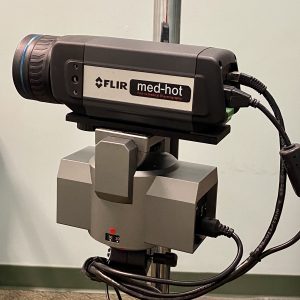Approach to Breast Screening
Limitations of breast cancer screening. For decades, medical scientists have argued that the best way to beat breast cancer is through early detection, as this result in a greater likelihood of curative treatment. Mammography has been viewed as the screening method of choice for detecting early-stage breast cancer. However, recent studies suggest that mammographic screening has not reduced the rate of advanced breast cancer and, at best, has only achieved a 10% reduction in breast cancer mortality.


The Ultimate Tool for Long-Term Breast Health

Improvements in survival are mainly attributed to better treatment, not mammographic screening. The U.S. Preventive Services Task Force now recommends that women 50–74 years of age be screened for breast cancer by mammography every two years. Women under age 50 tend to have dense breasts, and mammography often fails to detect cancer in these women until it has become more advanced.
The greatest documented value of breast thermography comes from performing serial images which over time can distinguish normal anatomy, which is consistent and generally unchanging, from new heat patterns which would be suspicious and lead to more detailed investigation. The first infrared imaging study provides a baseline against which future scans will be compared. The thermagraphic image is basically a color-coded “fingerprint” of the breast. If the pattern appears to be normal, then future scans should show the same pattern. Any change in this pattern is a cause for concern and may be followed by specific measures to improve breast health and change conditions that could set the stage for breast cancer.
A serious limitation of mammography is that it only detects cancer that has already formed into a tumor. A very different strategy is offered by breast thermography, which shifts the focus from the tumor itself to the fundamental processes that are needed for tumor growth and spread. These processes create new blood vessels and generate local increases in heat that can be measured accurately to tiny fractions of a degree using a specialized infrared camera. Such changes can then display as a spectrum of colors representing temperature, the so-called thermagram. With an abnormal thermagram, you can then embark on a breast health program that corrects the abnormal conditions before the tumor can develop into a malignant threat. Follow-up thermal imaging can then be used to determine if the conditions have returned to normal.
How does breast thermography work? As we noted above, breast thermography helps us detect those conditions that are likely to promote breast tumor growth. Angiogenesis and inflammation are two processes that can fuel the growth and progression of breast cancer. These processes result in increased temperature and vascular activity, both of which may show up as an abnormal thermagram or as “hot spots” that eventually may develop into a malignant tumor. Thermography can detect these early disease processes eight to ten years before the tumor is actually detected by mammography. We then use natural strategies aimed at angiogenesis and inflammation in order to discourage any potential cancer growth.
Breast thermography can detect early disease processes eight to ten years before the tumor is actually detected by mammography. The difference is that whereas mammography can only detect a tumor that has already developed, thermography provides an opportunity for changing those conditions that would promote tumor development in the first place.
A powerful risk-based screening strategy. Breast thermography is unique in its ability to enable assessment of one’s risk of breast cancer. Recent research indicates that an abnormal thermagram, in light of our present knowledge of breast cancer, is ten times as important a risk indicator as family history.
In a 2002 issue of IEEE Engineering in Medicine and Biology, scientists proposed that infrared imaging may be “the best, method for risk assessment in breast cancer…the presence of an abnormal asymmetric infrared heat pattern of the breasts probably increases a woman’s risk of getting breast cancer at least ten-fold.” A persistently abnormal thermagram is linked with a 30 to 40 percent increased chance of developing breast cancer within five to ten years—mammograms may be totally negative during this entire period of time.
Some Facts to Consider About Thermography
Safe, easy, pain-free and radiation-free
Provides a color-coded "fingerprint" of the breast
No contact or compression of breast tissue
Detects changes in breast tissue from the smallest of tumors
Identifies inflammatory breast cancer
Entire breast can be imaged
Identifies fibrocystic breast disease and tumor inflammation
Effectively and safely screens breasts with implants
Useful for evaluating chest wall after breast surgery
Effective for breasts of all sizes
Creates opportunities for early intervention
Sensitivity is superior to that of mammography and ideal in situations where mammograms tend to be inaccurate or unsafe
Emerging Concerns about Mammographic Screening
Recent studies suggest that annual mammograms may lead to excessive radiation exposure, which may pose a special risk to younger women and women who harbor the BRCA oncogenes. In addition, the physical pressure of the procedure could rupture an existing tumor and trigger metastasis. The emotional distress of “false positive” mammograms is considerable. In the August 2004 issue of Radiation Research, Heyes and Mill conclude: “The risks associated with mammography screening may be approximately five times higher than previously assumed.”
Breast thermography as a complementary screening option. Breast thermography, also known as digital infrared thermal imaging (DITI) and “infrared mammography”, received FDA approval in 1982. Since mammography is no longer part of standard guidelines for women under age 50, breast thermography has emerged as a viable option for these younger women as well as an excellent adjunctive approach for older women. We recommend annual thermagram beginning at age 40, and using these concurrently with mammograms after age 50 (with mammography being done every other year at that point).
Thermascan as a key to breast health. Remember that thermography enables you to be highly proactive about long-term breast health. It can help you put a stop to breast cancer long before it becomes a reality, or to treat cancer at an early stage, when it is most curable. With thermography, you can take steps to ward off a problem that would only be picked up much later by mammography. By using anti-cancer nutrition, herbal therapy, and other integrative medicine strategies, you can convert an abnormal thermagram back to a normal thermagram. This means that you are altering the conditions that support breast cancer and effectively getting your body back “in the clear.”
Recent research suggests that breast thermography can detect first signs of breast cancer 6 to 8 years before mammography, and that an abnormal thermagram is ten times as important as having a family history of breast cancer. Given the recently revised mammography guidelines, breast thermography may be the best screening option for women under 50, women with dense breasts, and older women who want more assurance that mammography is not missing a potential disease situation.

Office
4505 Fair Meadow Lane, Suite 111 Raleigh, NC 27607
5725 Oleander Drive, Suite B-5 Wilmington, NC 28403
7-C Corporate Center Ct Greensboro, NC 27408
To schedule an appointment in Raleigh, Wilmington or Greensboro...
Email: kelly@carolinacenter.com
You can also call (919) 781-6999 to schedule.
